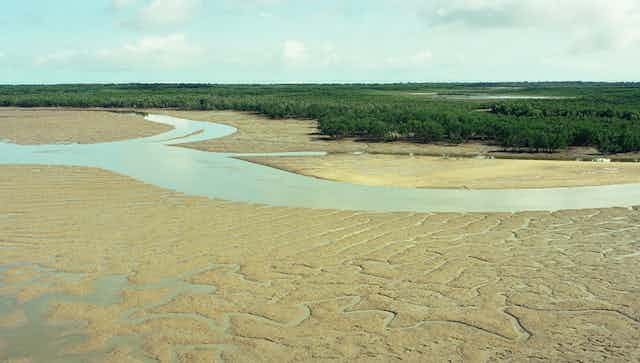Last Saturday, toxic material leaked from the Ranger uranium mine in the Northern Territory. The mine ceased operation in 2011 after more than 30 years in action, raising the question of what happens to a mine site once the mine closes down.
Rehabilitation - returning a site to the way it was before mining started - is the usual approach. But I believe there’s a better way.
I’m fixing a hole
A key “compliance step” in modern resource extraction, mandated under both Australian state and federal laws, is mine site rehabilitation. Under this model a mining company sets aside funds to rehabilitate areas once the resource is extracted. They can rehabilitate the entire site, or do parts progressively as the mine expands.
In natural settings, such as outback Australia, the usual approach is to sculpt the mined area to match the surrounding landscape. A layer of the original soil is spread over the land surface using a stockpile set up when mining began. Seeds of native species are collected from the surrounding area and sown on the soil to establish the original native vegetation.
On paper this seems like an entirely reasonable approach. But in reality restoration programs designed to return sites to their prior condition encounter numerous practical problems.
Australian landscapes have supported vegetation for millions of years. The plant-soil relationships are profoundly complex. When topsoil is stored during mining, in some cases for years, its biological properties change. That presents a serious problem, because many native plants are unable to thrive without symbiotic root fungi and soil bacteria.
And removing tens of metres of subsoil (the “overburden”), produces fundamentally different hydrological regimes affecting ground water storage and run-off.
Over the last 20 years enormous research effort has been directed towards overcoming the barriers to rehabilitating mine sites. Most of it has shown that in nearly every Australian environment it is extraordinary difficult to restore ecosystems back to their pre-mined condition. Restoration ecologists increasingly accept that it is not practically possible to replace what has been destroyed.
The mining industry’s financial resources are being frittered away pursuing unrealistic attempts to replace what existed before mining. The objectives of mine site restoration need to be reframed.
Biodiversity crisis, meet mine restoration crisis…
Conservation biologists are publicly protesting the collapse in government support for nature conservation. The outrage is entirely understandable given the potential catastrophic loss of Australia’s globally unique biological heritage.
Worse, some conservation biologists fear that Australia’s attitude could set a precedent for unravelling protected areas globally - their concern is that if a rich country like Australia can’t stay the course for protected natural areas then why expect much poorer countries to forgo resource exploitation?
Surprising as it sounds, the mining industry can - and should - create effective and financially sustainable conservation programs.
By definition, miners are land managers. They extract natural resources, acquire pastoral land surrounding mines, change hydrology regimes and destroy landforms and soils that have developed over geological time scales. All of this affects wildlife. The legacy of mining remains branded into landscapes for millennia.
There is no question mine sites need to be rehabilitated by replacing vegetation cover that is self sustaining and ecologically healthy. The issue is that the target of “restoring” what has been lost is unrealistic.
Rather than trying to paper over the cracks with mine restoration, it might be more effective to divert funding from mine site rehabilitation programs and use the money to buy and manage public and private nature conservation reserves.
Another option would be to create novel biodiverse-rich ecosystems specifically engineered to withstand the challenges of global environmental change. For example, novel habitats could be created to sustain wildlife: wetlands for waterfowl, and tracts of rainforests. Mine sites could become biological rich islands in otherwise uniform landscapes. For example, instead of establishing a fire prone savanna at Ranger Mine site, a fire-excluding rainforest could be established.
Money diverted from restoration could be spent on building fences to protect native animals from non-native predators, such as foxes, cats and wild dogs.
Even more radically, Australia could use the money to take on the conservation of large endangered species from around the world. Such schemes need significant investment and could become tourist draw-cards, creating ex situ populations of animals that may become extinct in their native habitats.
The mining industry and conservationists are typically understood as adversaries, but they could become allies. Partnerships between miners and conservationists could bring about real improvements to the country’s conservation record.
This demands fresh thinking. The first step is to challenge the orthodox assumption that mining companies should attempt to put Humpty Dumpty back together again.

